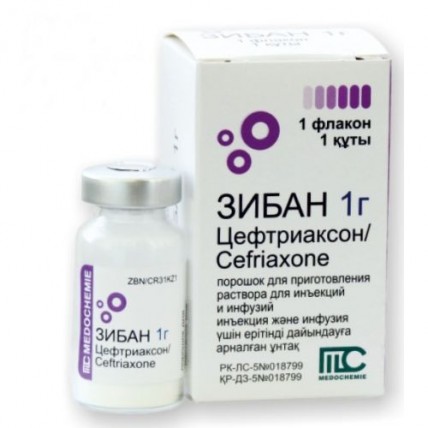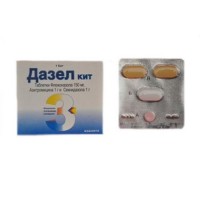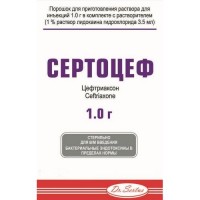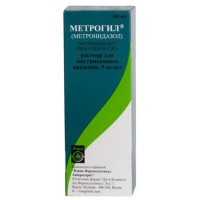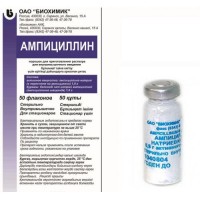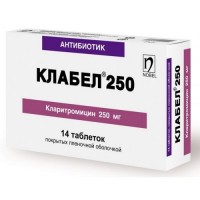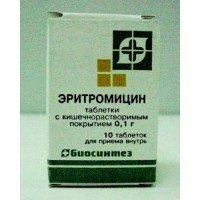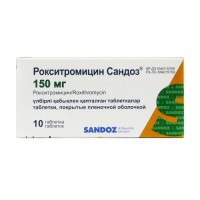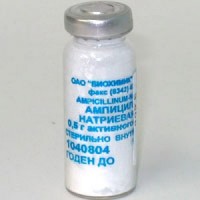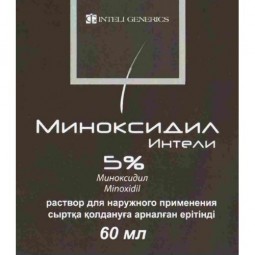Zyban 1's 1g powder for solution for injection and inf.
- $13.90
The instruction for medical use of Ziban Torgovoye medicine nazvaniyeziban the International unlicensed name Tseftriakson Lekarstvennaya a form Powder for preparation of solution for injections and infusions of 1.0 g Structure One bottle contains active agent - tseftriakson (in the form of a tseftriakson of sodium) 1.0 g the Description Almost white or yellowish crystal powder, is slightly hygroscopic Pharmacotherapeutic group Antibacterial drugs for system use. Beta laktamnye antibacterial drugs other. Cephalosporins of the third generation. Tseftriakson. The ATX J01DD04 code the Pharmacological Pharmacokinetics Concentration properties of a tseftriakson in blood depends on extent of its linking with albumine that defines drug pharmacokinetics. At the majority of therapeutic concentration free tseftriakson makes about 5%, increasing to 15% at concentration of 300 mg/l. Concentration of a free tseftriakson in interstitial liquid is higher, than its concentration in blood plasma, owing to the low content of albumine. At intramuscular introduction of 500 mg of a tseftriakson the peak concentration in blood plasma of 40mg/l-70mg/l is reached within 60 minutes, the bioavailability is 100%. At intravenous administration the peak concentration in blood plasma makes about 120 mg/l at a dosage of 500 mg and 200 mg/l at a dosage of 1 g. After the 30th minute infusion of 2 g of drug, its level in plasma is 250 mg/l. About 60% of drug are removed by kidneys in not changed look, due to glomerular filtration. The rest is removed through bile ducts and intestines. The renal clearance is 5–12 ml/min., the general clearance of plasma is 10–22 ml/min. Elimination half-life (Т½) at adults makes, about 8 hours. The method of administration, repeated introduction do not influence elimination half-life. Pharmacokinetics in special clinical situations. At newborns (aged up to 8 days), and also at elderly people Т½ is 2-3 times longer, than at adults. Any renal failure is capable to increase elimination half-life. Within the first month of life of the child T ½ decreases to the adult's level. Elimination half-life increases in a renal or liver failure, the renal failure leads to increase in discharge of drug with bile, the liver failure, in turn, leads to strengthening of removal of a tseftriakson kidneys. Tseftriakson well gets into cerebrospinal fluid (SMZh) at inflammation of a meninx, concentration of drug in SMZh makes 4% - 17% of appropriate level in blood plasma. A pharmacodynamics Tseftriakson - an antibiotic of a tsefalosporinovy number of the third generation. Possesses bactericidal action, growth of the majority of gram-positive and gram-negative microorganisms, due to suppression of synthesis of a cell wall of actively sharing bacteria, by accession to one or more penitsillinsvyazyvayushchy proteins oppresses. As a result the wall of a cell is damaged and becomes osmotically unstable. Cephalosporins reduce inhibition of hydrolases of murein, the enzyme participating in cell fission. Not inhibited enzyme can break integrity of a cell wall. Tseftriakson is active concerning the following microorganisms, including strains, the developing beta lactamazu (penicillinase). Sensitive microorganisms: Gram-positive aerobic: Staphylococcus aureus (Methicillinum - sensitive) *, Koagulazonegativnye staphylococcus (Methicillinum - sensitive) *, Streptococcus pyogenes (group A), Streptococcus agalacliae (group B), Streptococcus pneumoniae, viridans group Streptococci Gram-negative aerobic microorganisms: Borrelia burgdorferi, Haemophilus influenzae, Haemophilus parainfluenzae, Moraxella catarrhalis, Neisseria gonorrhea, Neisseria meningitidis, Proteus mirabilis, Providencia spp. Types for which the acquired sensitivity Gram-positive aerobic microorganisms is possible: Staphylococcus epidermidis **, Staphylococcus haemolyticus, Staphylococcus hominis Gram-negative aerobic microorganisms: Citrobacter freundii, Enterobacter aerogenes, Enterobacter cloacae, Escherichia coli ***, Klebsiella pneumonia ***, Klebsiella oxytoca ***, Morganella morganii, Proteus vulgaris, Serratia marcescens Anaerobe bacterias of Bacteroides spp., Fusobacterium spp., Peptostreptococcus spp., Clostridium perfringens Steady microorganisms Gram-positive aerobic microorganisms: Enterococcus spp., Listeria monocytogenes Gram-negative aerobic microorganisms: Acinetobacter baumannii, Pseudomonas aeruginosa, Stenotrophomonas maltophilia Anaerobe bacterias of Clostridium difficile Others: Chlamydia spp., Chlamydophila spp., Mycoplasma spp., Legionella spp., Ureaplasma urealyticum * All Methicillinum - steady staphylococcus, rezistentna to a tseftriakson. ** The percent of resistance & gt, 50%, at least in one region *** the Strains developed by ESBL always of a rezistenta Indications Ziban is appointed for treatment of the following infections at adults and children, including at the full-term newborns (since the birth): - bacterial meningitis - community-acquired pneumonia - intrahospital pneumonia - acute average otitis - infections of abdominal organs (peritonitis, infections of bilious ways and digestive tract) - the complicated infections of urinary tract (including pyelonephritis) - infections of bones and joints - the complicated infections of skin and soft tissues - gonorrhea - syphilis - a bacterial endocarditis Ziban can be used at: - exacerbation of a chronic obstructive pulmonary disease at adults - disseminated borreliosis of Lyme (early (a stage of II) and late (a stage of III)) at adults and children, including newborns aged from 15 days - preoperative prevention of infections, prevention of development of consecutive infection - treatment of the patients with a neutropenia having fever which is perhaps caused by a bacterial infection - treatment of patients with the bacteremia connected or the suspect with any of above-mentioned infections. The route of administration and doses the Dose of drug and a method of administration are defined with severity of an infection, sensitivity of an infestant and a condition of the patient. The therapeutic effect is usually reached at administration of drug daily once a day. The course of treatment depends on a course of the disease. Treatment needs to be continued within 48-72 hours after obtaining results of analyses about an eradikation of a microorganism or lack of temperature at the patient. The doses recommended for these indications. In especially hard case the purpose of doses in an upper limit of the recommended range is possible. Adults and children are more senior than 12 years (≥50 kg) of the Indication the Dosage * treatment Frequency ** Community-acquired pneumonia of 1-2 g of 1 times a day Aggravation chronic obstruktiv-ache pulmonary diseases of the Infection of abdominal organs the Complicated infections mochevyvodya-shchy ways Intrahospital pneumonia of 2 g -//-1 time in day -//-the Complicated infections of skin and soft tissues of the Infection of bones and joints Treatment of the patients with a neutropenia having fever which is perhaps caused by a bacterial infection of 2-4 g of 1 times a day the Bacterial endocarditis Bacterial meningitis * At the confirmed bacteremia is appointed a dose in an upper limit of the recommended range. ** Introduction twice a day is possible (each 12 hours) when assigning the dose exceeding 2 g daily. Acute average otitis: on 1-2 g of 1 times in day in oil. If the patient is in a serious condition or the previous therapy was inefficient, Ziban can be appointed intramusculary in a dose of 1-2 g a day within 3 days. Preoperative prevention of surgical infections of 2 g in the form of a single injection before surgery. Gonorrhea - 500 mg once in oil. Syphilis - usually recommended dose of 500mg-1g 1 times a day, for treatment of neurosyphilis a dose can be increased up to 2 g of 1 times a day within 10-14 days. Data on Ziban's dosing in syphilis, including neurosyphilis, are limited. Therefore it is necessary to adhere to national or local leaders. Disseminated borreliosis of Lyme (initial
and final
stages) - 2 g of 1 times a day within 14-21 days. The recommended duration of treatment varies. It is necessary to adhere to national or local leaders. Children Newborns, babies and children from 15 days to 12 years (& lt, 50 kg) Indications the Dosage * treatment Frequency ** the Intraabdominal infection of 50-80 mg/kg of 1 times a day the Complicated infections of urinary tract (including pyelonephritis) Community-acquired pneumonia -//-//-Intrahospital pneumonia the Complicated infections of skin and soft tissues of the Infection of bones and joints of 50-100 mg/kg (max. 4 g) of 1 times a day the Treatment of patients with neytro-a stone pine, having fever which is perhaps caused by a bacterial infection Bacterial meningitis of 80-100 mg/kg (at most 4 g) of 1 times a day the Bacterial endocarditis of 100 mg/kg (at most 4 g) of 1 times a day * At the confirmed bacteremia, is appointed a dose in an upper limit of the recommended range. ** Introduction two times a day (each 12 hours) is possible when assigning the dose exceeding 2 g daily. Indications for newborns, babies and children from 15 days to 12 years (& lt, 50 kg) who demand a specific mode of dosing: Acute average otitis In an initiation of treatment of acute average otitis, Ziban is entered in the form of a single intramuscular injection in a dose of 50 mg/kg. If the child is in a serious condition or the previous therapy was inefficient, Ziban it is possible to enter intramusculary in a dose 50 mg/kg a day within 3 days. Preoperative prevention of surgical infections - 50-80 mg/kg in the form of a single injection before surgery. Gonorrhea - 500 mg in the form of a single intramuscular injection. Syphilis - the usual recommended dose of 75-100 mg/kg (at most 4 g) once a day within 10-14 days. Data on Ziban's dosing in syphilis, including neurosyphilis, are limited. Therefore it is necessary to adhere to national or local leaders. Disseminated borreliosis of Lyme (initial
and final
stages) 50 - 80 mg/kg once a day within 14-21 days. The recommended course of treatment varies. It is necessary to adhere to national or local leaders. Newborn 0-14 days Ziban is contraindicated to premature newborns aged up to 41 weeks considering the term of pre-natal development (gestational age + age after the birth). Indications the Dosage * treatment Frequency * the Intraabdominal infection of 20-50 mg/kg of 1 times a day the Complicated infections of urinary tract (including pyelonephritis) Community-acquired pneumonia Intrahospital pneumonia the Complicated infections of skin and soft tissues of the Infection of bones and joints Treatment of the patients with a neutropenia having fever which is perhaps caused by a bacterial infection Bacterial meningitis of 50 mg/kg of 1 times a day the Bacterial endocarditis * At the confirmed bacteremia is appointed a dose in an upper limit of the recommended range. Not to exceed the maximum daily dose of 50 mg/kg of body weight. Indications for newborns at the age of 0-14 days which demand a specific mode of dosing: Acute average otitis In an initiation of treatment of acute average otitis, Ziban is entered in the form of a single intramuscular injection in a dose of 50 mg/kg. Preoperative prevention of surgical infections of 20 - 50 mg/kg in the form of a single injection before operation. Gonorrhea - 500 mg once intramusculary. Syphilis usually recommended dose makes 50 mg/kg within 10-14 days once a day. Data on Ziban's dosing in syphilis, including neurosyphilis, are limited. Therefore it is necessary to adhere to national or local leaders. Elderly patients For elderly patients the dose adjustment is not required provided that renal and hepatic functions are satisfactory. Renal and liver failure: Decrease in a dosage of Ziban for patients, with a renal failure is not required if functions of a liver are not broken. In case of a renal failure of heavy degree (clearance of creatinine & lt, 10 ml a minute) the daily dose should not exceed 2 g. Decrease in a dosage of Ziban for patients with a liver failure it is not required if function of kidneys is not broken. Patients with the acute renal failure accompanied with insufficiency of function of a liver need to lower a dosage of drug and to control its concentration in blood plasma. Patients who are on dialysis: Introduction of an additional dose of drug after dialysis is not required. Reduction in the rate of its removal is possible therefore it is necessary to control Ziban's concentration in plasma and in case of need to modify a dose. Clinical control of safety and efficiency is recommended to patients with a heavy liver and renal failure. The method of administration Ziban is entered by intravenous infusion (within not less than 30 minutes (preferable method of administration)), an intravenous injection within 5 min. or by a deep intramuscular injection. The intravenous faltering injection within 5 minutes is preferable in large veins. Introduction intravenously of a dose of 50 mg/kg or to more babies and children aged up to 12 years is entered in the form of infusion. At newborns the intravenous infusion is carried out within 60 minutes to reduce potential risk of bilirubinovy encephalopathy. Intramuscular introduction should be considered when intravenous administration is impossible or is not suitable for the patient. Intramuscular injections are entered into a big gluteus. If the dosage exceeds 1 g, it needs to be divided and entered into both buttocks. Doses, more than 2 g are entered intravenously. If lidocaine is used as solvent, then solution is not entered intravenously. For Ziban's dissolution or further cultivation of the received solution for intravenous administration, it is not recommended to use solvents, calciferous (Ringera solution, Hartman's solution) since there is a risk of emergence of a deposit of tseftriakson-calcium. Also tseftriakson do not mix and do not enter along with kaltsiysoderzhashchy drugs in one catheter for intravenous introduction. Tseftriakson is contraindicated to newborns (≤ 28 days) if it is required (it is expected that will be required) treatment by kaltsiysoderzhashchy intravenous solutions, including continuous infusions of calcium (parenteral nutrition), because of risk of sedimentation of tseftriakson-calcium. For preoperative prevention of surgical infections, tseftriakson it is entered in 30-90 minutes prior to operation. Preparation of solution for injections: Preparation of solution is carried out in the corresponding conditions, a voizbezhaniye of microbic pollution. It is necessary to use only freshly cooked solutions. Ready solution can be stored within 6 hours at a temperature below 25 °C, and till 12 o'clock at a temperature from 2 to 8 °C. Color of the prepared solution varies from faintly yellow to amber. If in ready solution foreign impurity are visually noted, it is impossible to use it. For an intramuscular injection - 1% lidocaine solution is used. 1 g of Ziban dissolve 1% of solution of lidocaine in 3.5 ml. The powder divorced in lidocaine solution cannot be entered intravenously! For an intravenous injection - water for injections is used, 250 mg and 500 mg of Ziban dissolve in 5 ml of water for injections, 1 g dissolve in 10 ml of water for injections. The drug is administered by a slow intravenous injection within 5 minutes. For intravenous infusion - 2 g of Ziban part in 40 ml of one of solutions stated below, not calciferous: 5% or 10% dextrose solution, solution of sodium of chloride and glucose (0.45% solution of sodium of chloride and 2.5% glucose solution), 6% a dextran in 5% solution of glucose, 6-10% hydroxyethylstarch solution in isotonic solution of sodium of chloride. The drug is administered by infusion within 30 minutes. The bottle of the drug Ziban is intended only for single use, the remained solution/powder should be utilized. Side effects Often - an eosinophilia, a leukopenia, thrombocytopenia - diarrhea - increase in level of liver enzymes - rash Infrequently - a headache, dizziness - a granulotsiopeniya, anemia, a coagulopathy - development of a fungal infection of genitals - nausea, vomiting - an itching - in the place of an injection pain, phlebitis, fever - the increased creatinine level in blood is rare - a pseudomembrane
ny colitis - a bronchospasm - a small tortoiseshell - a hamaturia, a glucosuria - hypostasis in the injection site - a fever Frequency is unknown - a suprinfektion - hemolytic anemia - an agranulocytosis - anaphylactic, anaphylactoid reactions, hypersensitivity, an acute anaphylaxis - spasms - vertigo - stomatitis, a glossitis, pancreatitis - precipitation (calcium sedimentation) in a gall bladder, bilirubinovy encephalopathy - sharp generalized exanthematous pustulez, Stephens's syndrome - Johnson, a toxic epidermal necrolysis (Lyell's disease), a multiformny erythema - an oligouriya, precipitation (calcium sedimentation) in kidneys (reversible) - false positive results of test of Koombs, the test for a galactosemia, non-enzymatic methods of definition of glucose in urine. Contraindications - hypersensitivity to a tseftriakson, penicillin, cephalosporins or another beta laktamnym antibiotics - premature newborns aged up to 41 weeks (considering the term of pre-natal development (weeks of pregnancy) + weeks after the birth) - the full-term newborns (aged up to 28 days) with a hyperbilirubinemia, jaundice, a hypoalbuminemia or acidosis, owing to a possibility of disturbance of binding of bilirubin, in case of need intravenous administration of calcium or solutions, calciferous (owing to risk of emergence of a deposit tseftriakson-calcium) Before an intramuscular injection, with use of lidocaine as solvent, should exclude the contraindications connected with administration of lidocaine. The solutions of a tseftriakson containing lidocaine cannot be entered intravenously. Medicinal interactions the Calcium-containing solvents (Ringera solution or Gartman's solution), are not used for restoration or further dilution for intravenous administration, because of possible sedimentation. Emergence of a deposit of tseftriakson-calcium is possible when mixing a tseftriakson with solutions calciferous in one catheter for intravenous administration. Tseftriakson is not entered along with kaltsiysoderzhashchy intravenous solutions, including continuous infusions calcium of the containing solutions, such as parenteral nutrition through Y-shaped injection port. However introduction of a tseftriakson and kaltsiysoderzhashchy solutions consistently, one after another, (except for use for newborns as they have an increased risk of formation of precipitated calcium superphosphate tseftriakson calcium) is possible if catheters for infusion are carefully washed out between infusions by the corresponding liquids. At simultaneous use of oral anticoagulants and a tsevtriaksona risk of development of deficiency of vitamin K increases that can lead to bleeding. It is necessary to control carefully INR (the international normalized relation) and to use adequate dose adjustment of vitamin K in time and after treatment tseftriaksony. There are no data on interaction between tseftriaksony and peroral calcium - the containing drugs or interaction between tseftriaksony for intramuscular maintaining and calcium - the containing drugs (entered intravenously or orally). After simultaneous introduction of a high dose of a tseftriakson and loopback diuretics (for example, furosemide) deterioration in function of kidneys was not observed. Simultaneous introduction of a probenetsid does not reduce removal of a tseftriakson. At joint intake of chloramphenicol and a tseftriakson the antagonistic effect is observed. Tseftriakson is incompatible with amsakriny, Vancomycinum, flukonazoly and aminoglycosides. In rare instances tseftriakson can cause false positive results at Koombs's test, definition of a galactosemia, definition of glucose in urine by a non-enzymatic method. Therefore, determination of level of glucose in urine during therapy with tseftriaksony is recommended to be carried out by an enzymatic method. Special instructions it is not necessary to exceed the recommended dose. Before an initiation of treatment Ziban it is necessary to collect carefully the allergological anamnesis, for determination of possible hypersensitivity to a tseftriakson, cephalosporins, penicillin or another beta laktamnym to antibiotics, lidocaine. Patients with the burdened allergic anamnesis should appoint Ziban with care. In case of development of heavy reaction of hypersensitivity the treatment tseftriaksony has to be the corresponding therapy is immediately stopped and is appointed. Ziban's use, as well as other antibacterial drugs, can provoke diarrhea, colitis, including pseudomembranous. In case of developing of diarrhea after an initiation of treatment by Ziban, it is necessary to appoint symptomatic therapy. At a severe form of diarrhea or a bloody diarrhea Ziban's use it is necessary to stop and appoint symptomatic treatment of Clostridium difficile. Prescribing of the drugs inhibiting a vermicular movement is not recommended. The patients who had gastrointestinal diseases, in particular colitis should apply Ziban with care. As well as in a case with other cephalosporins, the overgrowth of microorganisms, insensitive to a tseftriakson, such as enterococci and Candida spp can cause prolonged use of Ziban. Decrease in a dosage is recommended to patients with an acute renal failure of the heavy severity which is followed by a liver failure (see. "Route of administration and dosing"). Interaction with kaltsiysoderzhashchy drugs: there is information on cases of a lethal outcome with formation of precipitated calcium superphosphates of tseftriakson-calcium in lungs and kidneys of the premature and full-term newborns aged up to 1 month. There are no scientific data confirming intravascular precipitated calcium superphosphate at other groups of patients except the newborns receiving tseftriakson and kaltsiysoderzhashchy solutions or any other drugs. Newborns have the increased risk of formation of precipitated calcium superphosphate of tseftriakson-calcium in comparison with other age groups. At patients of any age tseftriakson it is not necessary to mix or enter along with any intravenous solutions, calciferous, even through different infusional catheters and/or into different injection sites. Nevertheless, at patients, 28 days are more senior to avoid sedimentation, tseftriakson and calcium the containing solutions can be entered consistently, one by one, if infusional catheters are entered into different places, are replaced or washed carefully out, between infusions, normal saline solution. At patients of the solutions of full parenteral nutrition demanding continuous introduction with calcium (PPP solutions), the doctor can consider the possibility of use of alternative antibacterial drugs which do not bear similar risk of sedimentation. If use of a tseftriakson is considered necessary at the patients demanding a continuous power PPP solutions and tseftriakson it is possible to enter at the same time, but through different catheters into different injection sites. As an alternative, administration of PPP solutions can be stopped for the period of infusion of a tseftriakson, and infusional catheters are washed out. Tseftriakson is capable to force out bilirubin from seralbumin that can cause a hyperbilirubinemia. Newborns should appoint drug with care. With extra care premature children should appoint drug. Ziban is contraindicated to the premature and full-term newborns with risk of developing bilirubinovy encephalopathy. Cases of development of autoimmune hemolytic anemia, including with a lethal outcome, at adults and children of the cephalosporins receiving antibacterial drugs of group, including tseftriakson are described. In case of appearance of anemia during treatment by Ziban, it is necessary to cancel administration of drug before identification of an etiology of anemia. Disodium salt of a tseftriakson can form precipitated calcium superphosphates in a gall bladder which at ultrasonography are visible as shading. Patients of any age, however most often the babies and small children receiving drug in the dosage exceeding body weight proportions are subject to it. At a dosage of the body weight exceeding 80 mg/kg, there is a risk of emergence of a biliary deposit therefore it is necessary to avoid exceeding a dosage. In the absence of data of the gallstones confirming development or acute cholecystitis, for treatment of similar reactions among the children receiving Ziban the conservative treatment is recommended. Among the patients receiving Ziban cases of developing of the pancreatitis caused by obstruction of bile ducts were seldom observed. In most cases risk factors of emergence of stagnation of bile and a biliary deposit are the previous treatment, a serious illness or the full parenteral nutrition (FPN). However you should not exclude a possible role of Ziban in emergence of a biliary deposit. Antibacterial drugs of group of cephalosporins are characterized by absorption in a membrane of erythrocytes and react with antibodies that can cause positive take of test of Koombs. The cross-responsiveness with penicillin is also possible. Ziban has a limited range of antibacterial activity and is not used as monotherapy for treatment of some types of infections if the activator is not confirmed laboratory yet. In a polymicrobial infection when existence of the activator resistant to a tseftriakson is supposed, purpose of an additional antibiotic is recommended. During a long course of treatment Ziban recommended regular monitoring of complete analysis of blood. Each gram of Ziban contains about 3.6 mmol of sodium. It should be considered at treatment of the patients who are on a diet with sodium restriction. Pregnancy and the period of a lactation Use of the drug Ziban in II and III trimesters of pregnancy is possible only when the expected advantage for mother exceeds potential risk for a fruit (tseftriakson gets through a placental barrier). In need of use of the drug Ziban in the period of a lactation it is necessary to resolve an issue of the breastfeeding termination (tseftriakson it is allocated with breast milk). Features of influence of medicine on ability to run the vehicle or potentially dangerous mechanisms Considering side effects of drug (dizziness, a headache) it is necessary to be careful at control of transport or other potentially dangerous mechanisms. Overdose Symptoms: strengthening of symptoms of side reactions, described above. Treatment: symptomatic and maintenance therapy and also strict observance of the instruction for use. The hemodialysis or peritoneal dialysis are inefficient. Special antidote does not exist. The form of release and packing place Powder in the glass bottles which are hermetically corked by rubber bungs, rolled up by aluminum covers and a plastic cap. On 1 and 10 bottles together the instruction for medical use in the state and Russian languages place in a pack from cardboard Storage conditions to Store in the dry, protected from light place at a temperature not above 25 °C. To store out of children's reach! A period of storage 3 years not to use drug after expiry date.
To Develop prescription status According to the prescription & n
and final
stages) - 2 g of 1 times a day within 14-21 days. The recommended duration of treatment varies. It is necessary to adhere to national or local leaders. Children Newborns, babies and children from 15 days to 12 years (& lt, 50 kg) Indications the Dosage * treatment Frequency ** the Intraabdominal infection of 50-80 mg/kg of 1 times a day the Complicated infections of urinary tract (including pyelonephritis) Community-acquired pneumonia -//-//-Intrahospital pneumonia the Complicated infections of skin and soft tissues of the Infection of bones and joints of 50-100 mg/kg (max. 4 g) of 1 times a day the Treatment of patients with neytro-a stone pine, having fever which is perhaps caused by a bacterial infection Bacterial meningitis of 80-100 mg/kg (at most 4 g) of 1 times a day the Bacterial endocarditis of 100 mg/kg (at most 4 g) of 1 times a day * At the confirmed bacteremia, is appointed a dose in an upper limit of the recommended range. ** Introduction two times a day (each 12 hours) is possible when assigning the dose exceeding 2 g daily. Indications for newborns, babies and children from 15 days to 12 years (& lt, 50 kg) who demand a specific mode of dosing: Acute average otitis In an initiation of treatment of acute average otitis, Ziban is entered in the form of a single intramuscular injection in a dose of 50 mg/kg. If the child is in a serious condition or the previous therapy was inefficient, Ziban it is possible to enter intramusculary in a dose 50 mg/kg a day within 3 days. Preoperative prevention of surgical infections - 50-80 mg/kg in the form of a single injection before surgery. Gonorrhea - 500 mg in the form of a single intramuscular injection. Syphilis - the usual recommended dose of 75-100 mg/kg (at most 4 g) once a day within 10-14 days. Data on Ziban's dosing in syphilis, including neurosyphilis, are limited. Therefore it is necessary to adhere to national or local leaders. Disseminated borreliosis of Lyme (initial
and final
stages) 50 - 80 mg/kg once a day within 14-21 days. The recommended course of treatment varies. It is necessary to adhere to national or local leaders. Newborn 0-14 days Ziban is contraindicated to premature newborns aged up to 41 weeks considering the term of pre-natal development (gestational age + age after the birth). Indications the Dosage * treatment Frequency * the Intraabdominal infection of 20-50 mg/kg of 1 times a day the Complicated infections of urinary tract (including pyelonephritis) Community-acquired pneumonia Intrahospital pneumonia the Complicated infections of skin and soft tissues of the Infection of bones and joints Treatment of the patients with a neutropenia having fever which is perhaps caused by a bacterial infection Bacterial meningitis of 50 mg/kg of 1 times a day the Bacterial endocarditis * At the confirmed bacteremia is appointed a dose in an upper limit of the recommended range. Not to exceed the maximum daily dose of 50 mg/kg of body weight. Indications for newborns at the age of 0-14 days which demand a specific mode of dosing: Acute average otitis In an initiation of treatment of acute average otitis, Ziban is entered in the form of a single intramuscular injection in a dose of 50 mg/kg. Preoperative prevention of surgical infections of 20 - 50 mg/kg in the form of a single injection before operation. Gonorrhea - 500 mg once intramusculary. Syphilis usually recommended dose makes 50 mg/kg within 10-14 days once a day. Data on Ziban's dosing in syphilis, including neurosyphilis, are limited. Therefore it is necessary to adhere to national or local leaders. Elderly patients For elderly patients the dose adjustment is not required provided that renal and hepatic functions are satisfactory. Renal and liver failure: Decrease in a dosage of Ziban for patients, with a renal failure is not required if functions of a liver are not broken. In case of a renal failure of heavy degree (clearance of creatinine & lt, 10 ml a minute) the daily dose should not exceed 2 g. Decrease in a dosage of Ziban for patients with a liver failure it is not required if function of kidneys is not broken. Patients with the acute renal failure accompanied with insufficiency of function of a liver need to lower a dosage of drug and to control its concentration in blood plasma. Patients who are on dialysis: Introduction of an additional dose of drug after dialysis is not required. Reduction in the rate of its removal is possible therefore it is necessary to control Ziban's concentration in plasma and in case of need to modify a dose. Clinical control of safety and efficiency is recommended to patients with a heavy liver and renal failure. The method of administration Ziban is entered by intravenous infusion (within not less than 30 minutes (preferable method of administration)), an intravenous injection within 5 min. or by a deep intramuscular injection. The intravenous faltering injection within 5 minutes is preferable in large veins. Introduction intravenously of a dose of 50 mg/kg or to more babies and children aged up to 12 years is entered in the form of infusion. At newborns the intravenous infusion is carried out within 60 minutes to reduce potential risk of bilirubinovy encephalopathy. Intramuscular introduction should be considered when intravenous administration is impossible or is not suitable for the patient. Intramuscular injections are entered into a big gluteus. If the dosage exceeds 1 g, it needs to be divided and entered into both buttocks. Doses, more than 2 g are entered intravenously. If lidocaine is used as solvent, then solution is not entered intravenously. For Ziban's dissolution or further cultivation of the received solution for intravenous administration, it is not recommended to use solvents, calciferous (Ringera solution, Hartman's solution) since there is a risk of emergence of a deposit of tseftriakson-calcium. Also tseftriakson do not mix and do not enter along with kaltsiysoderzhashchy drugs in one catheter for intravenous introduction. Tseftriakson is contraindicated to newborns (≤ 28 days) if it is required (it is expected that will be required) treatment by kaltsiysoderzhashchy intravenous solutions, including continuous infusions of calcium (parenteral nutrition), because of risk of sedimentation of tseftriakson-calcium. For preoperative prevention of surgical infections, tseftriakson it is entered in 30-90 minutes prior to operation. Preparation of solution for injections: Preparation of solution is carried out in the corresponding conditions, a voizbezhaniye of microbic pollution. It is necessary to use only freshly cooked solutions. Ready solution can be stored within 6 hours at a temperature below 25 °C, and till 12 o'clock at a temperature from 2 to 8 °C. Color of the prepared solution varies from faintly yellow to amber. If in ready solution foreign impurity are visually noted, it is impossible to use it. For an intramuscular injection - 1% lidocaine solution is used. 1 g of Ziban dissolve 1% of solution of lidocaine in 3.5 ml. The powder divorced in lidocaine solution cannot be entered intravenously! For an intravenous injection - water for injections is used, 250 mg and 500 mg of Ziban dissolve in 5 ml of water for injections, 1 g dissolve in 10 ml of water for injections. The drug is administered by a slow intravenous injection within 5 minutes. For intravenous infusion - 2 g of Ziban part in 40 ml of one of solutions stated below, not calciferous: 5% or 10% dextrose solution, solution of sodium of chloride and glucose (0.45% solution of sodium of chloride and 2.5% glucose solution), 6% a dextran in 5% solution of glucose, 6-10% hydroxyethylstarch solution in isotonic solution of sodium of chloride. The drug is administered by infusion within 30 minutes. The bottle of the drug Ziban is intended only for single use, the remained solution/powder should be utilized. Side effects Often - an eosinophilia, a leukopenia, thrombocytopenia - diarrhea - increase in level of liver enzymes - rash Infrequently - a headache, dizziness - a granulotsiopeniya, anemia, a coagulopathy - development of a fungal infection of genitals - nausea, vomiting - an itching - in the place of an injection pain, phlebitis, fever - the increased creatinine level in blood is rare - a pseudomembrane
ny colitis - a bronchospasm - a small tortoiseshell - a hamaturia, a glucosuria - hypostasis in the injection site - a fever Frequency is unknown - a suprinfektion - hemolytic anemia - an agranulocytosis - anaphylactic, anaphylactoid reactions, hypersensitivity, an acute anaphylaxis - spasms - vertigo - stomatitis, a glossitis, pancreatitis - precipitation (calcium sedimentation) in a gall bladder, bilirubinovy encephalopathy - sharp generalized exanthematous pustulez, Stephens's syndrome - Johnson, a toxic epidermal necrolysis (Lyell's disease), a multiformny erythema - an oligouriya, precipitation (calcium sedimentation) in kidneys (reversible) - false positive results of test of Koombs, the test for a galactosemia, non-enzymatic methods of definition of glucose in urine. Contraindications - hypersensitivity to a tseftriakson, penicillin, cephalosporins or another beta laktamnym antibiotics - premature newborns aged up to 41 weeks (considering the term of pre-natal development (weeks of pregnancy) + weeks after the birth) - the full-term newborns (aged up to 28 days) with a hyperbilirubinemia, jaundice, a hypoalbuminemia or acidosis, owing to a possibility of disturbance of binding of bilirubin, in case of need intravenous administration of calcium or solutions, calciferous (owing to risk of emergence of a deposit tseftriakson-calcium) Before an intramuscular injection, with use of lidocaine as solvent, should exclude the contraindications connected with administration of lidocaine. The solutions of a tseftriakson containing lidocaine cannot be entered intravenously. Medicinal interactions the Calcium-containing solvents (Ringera solution or Gartman's solution), are not used for restoration or further dilution for intravenous administration, because of possible sedimentation. Emergence of a deposit of tseftriakson-calcium is possible when mixing a tseftriakson with solutions calciferous in one catheter for intravenous administration. Tseftriakson is not entered along with kaltsiysoderzhashchy intravenous solutions, including continuous infusions calcium of the containing solutions, such as parenteral nutrition through Y-shaped injection port. However introduction of a tseftriakson and kaltsiysoderzhashchy solutions consistently, one after another, (except for use for newborns as they have an increased risk of formation of precipitated calcium superphosphate tseftriakson calcium) is possible if catheters for infusion are carefully washed out between infusions by the corresponding liquids. At simultaneous use of oral anticoagulants and a tsevtriaksona risk of development of deficiency of vitamin K increases that can lead to bleeding. It is necessary to control carefully INR (the international normalized relation) and to use adequate dose adjustment of vitamin K in time and after treatment tseftriaksony. There are no data on interaction between tseftriaksony and peroral calcium - the containing drugs or interaction between tseftriaksony for intramuscular maintaining and calcium - the containing drugs (entered intravenously or orally). After simultaneous introduction of a high dose of a tseftriakson and loopback diuretics (for example, furosemide) deterioration in function of kidneys was not observed. Simultaneous introduction of a probenetsid does not reduce removal of a tseftriakson. At joint intake of chloramphenicol and a tseftriakson the antagonistic effect is observed. Tseftriakson is incompatible with amsakriny, Vancomycinum, flukonazoly and aminoglycosides. In rare instances tseftriakson can cause false positive results at Koombs's test, definition of a galactosemia, definition of glucose in urine by a non-enzymatic method. Therefore, determination of level of glucose in urine during therapy with tseftriaksony is recommended to be carried out by an enzymatic method. Special instructions it is not necessary to exceed the recommended dose. Before an initiation of treatment Ziban it is necessary to collect carefully the allergological anamnesis, for determination of possible hypersensitivity to a tseftriakson, cephalosporins, penicillin or another beta laktamnym to antibiotics, lidocaine. Patients with the burdened allergic anamnesis should appoint Ziban with care. In case of development of heavy reaction of hypersensitivity the treatment tseftriaksony has to be the corresponding therapy is immediately stopped and is appointed. Ziban's use, as well as other antibacterial drugs, can provoke diarrhea, colitis, including pseudomembranous. In case of developing of diarrhea after an initiation of treatment by Ziban, it is necessary to appoint symptomatic therapy. At a severe form of diarrhea or a bloody diarrhea Ziban's use it is necessary to stop and appoint symptomatic treatment of Clostridium difficile. Prescribing of the drugs inhibiting a vermicular movement is not recommended. The patients who had gastrointestinal diseases, in particular colitis should apply Ziban with care. As well as in a case with other cephalosporins, the overgrowth of microorganisms, insensitive to a tseftriakson, such as enterococci and Candida spp can cause prolonged use of Ziban. Decrease in a dosage is recommended to patients with an acute renal failure of the heavy severity which is followed by a liver failure (see. "Route of administration and dosing"). Interaction with kaltsiysoderzhashchy drugs: there is information on cases of a lethal outcome with formation of precipitated calcium superphosphates of tseftriakson-calcium in lungs and kidneys of the premature and full-term newborns aged up to 1 month. There are no scientific data confirming intravascular precipitated calcium superphosphate at other groups of patients except the newborns receiving tseftriakson and kaltsiysoderzhashchy solutions or any other drugs. Newborns have the increased risk of formation of precipitated calcium superphosphate of tseftriakson-calcium in comparison with other age groups. At patients of any age tseftriakson it is not necessary to mix or enter along with any intravenous solutions, calciferous, even through different infusional catheters and/or into different injection sites. Nevertheless, at patients, 28 days are more senior to avoid sedimentation, tseftriakson and calcium the containing solutions can be entered consistently, one by one, if infusional catheters are entered into different places, are replaced or washed carefully out, between infusions, normal saline solution. At patients of the solutions of full parenteral nutrition demanding continuous introduction with calcium (PPP solutions), the doctor can consider the possibility of use of alternative antibacterial drugs which do not bear similar risk of sedimentation. If use of a tseftriakson is considered necessary at the patients demanding a continuous power PPP solutions and tseftriakson it is possible to enter at the same time, but through different catheters into different injection sites. As an alternative, administration of PPP solutions can be stopped for the period of infusion of a tseftriakson, and infusional catheters are washed out. Tseftriakson is capable to force out bilirubin from seralbumin that can cause a hyperbilirubinemia. Newborns should appoint drug with care. With extra care premature children should appoint drug. Ziban is contraindicated to the premature and full-term newborns with risk of developing bilirubinovy encephalopathy. Cases of development of autoimmune hemolytic anemia, including with a lethal outcome, at adults and children of the cephalosporins receiving antibacterial drugs of group, including tseftriakson are described. In case of appearance of anemia during treatment by Ziban, it is necessary to cancel administration of drug before identification of an etiology of anemia. Disodium salt of a tseftriakson can form precipitated calcium superphosphates in a gall bladder which at ultrasonography are visible as shading. Patients of any age, however most often the babies and small children receiving drug in the dosage exceeding body weight proportions are subject to it. At a dosage of the body weight exceeding 80 mg/kg, there is a risk of emergence of a biliary deposit therefore it is necessary to avoid exceeding a dosage. In the absence of data of the gallstones confirming development or acute cholecystitis, for treatment of similar reactions among the children receiving Ziban the conservative treatment is recommended. Among the patients receiving Ziban cases of developing of the pancreatitis caused by obstruction of bile ducts were seldom observed. In most cases risk factors of emergence of stagnation of bile and a biliary deposit are the previous treatment, a serious illness or the full parenteral nutrition (FPN). However you should not exclude a possible role of Ziban in emergence of a biliary deposit. Antibacterial drugs of group of cephalosporins are characterized by absorption in a membrane of erythrocytes and react with antibodies that can cause positive take of test of Koombs. The cross-responsiveness with penicillin is also possible. Ziban has a limited range of antibacterial activity and is not used as monotherapy for treatment of some types of infections if the activator is not confirmed laboratory yet. In a polymicrobial infection when existence of the activator resistant to a tseftriakson is supposed, purpose of an additional antibiotic is recommended. During a long course of treatment Ziban recommended regular monitoring of complete analysis of blood. Each gram of Ziban contains about 3.6 mmol of sodium. It should be considered at treatment of the patients who are on a diet with sodium restriction. Pregnancy and the period of a lactation Use of the drug Ziban in II and III trimesters of pregnancy is possible only when the expected advantage for mother exceeds potential risk for a fruit (tseftriakson gets through a placental barrier). In need of use of the drug Ziban in the period of a lactation it is necessary to resolve an issue of the breastfeeding termination (tseftriakson it is allocated with breast milk). Features of influence of medicine on ability to run the vehicle or potentially dangerous mechanisms Considering side effects of drug (dizziness, a headache) it is necessary to be careful at control of transport or other potentially dangerous mechanisms. Overdose Symptoms: strengthening of symptoms of side reactions, described above. Treatment: symptomatic and maintenance therapy and also strict observance of the instruction for use. The hemodialysis or peritoneal dialysis are inefficient. Special antidote does not exist. The form of release and packing place Powder in the glass bottles which are hermetically corked by rubber bungs, rolled up by aluminum covers and a plastic cap. On 1 and 10 bottles together the instruction for medical use in the state and Russian languages place in a pack from cardboard Storage conditions to Store in the dry, protected from light place at a temperature not above 25 °C. To store out of children's reach! A period of storage 3 years not to use drug after expiry date.
To Develop prescription status According to the prescription & n
